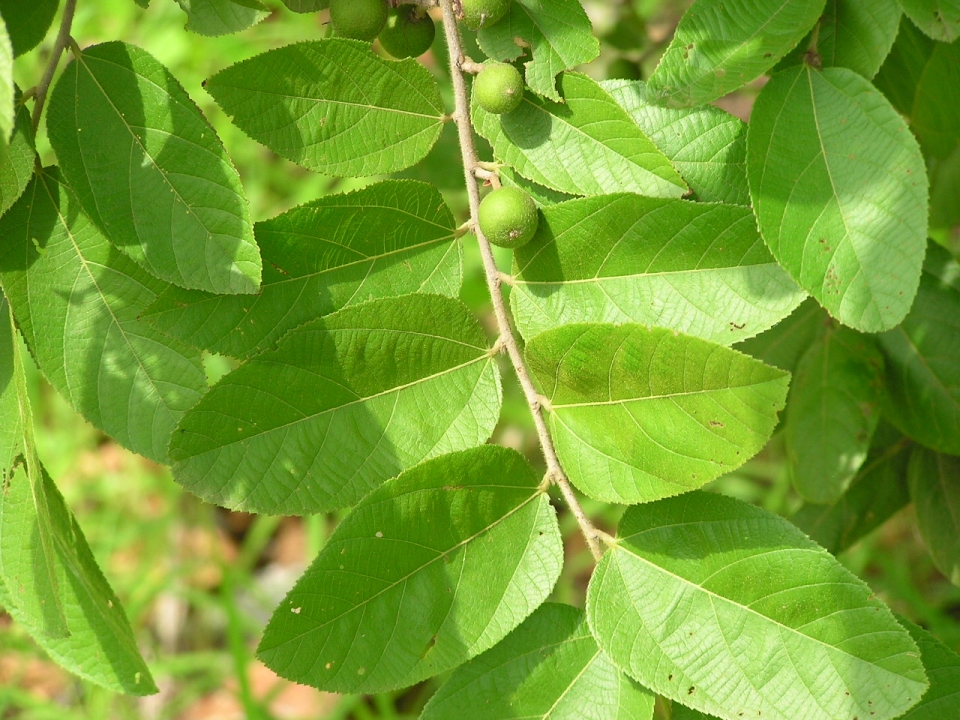Grewia mollis

|
|
Grewia mollis Common Names: Local Names:
Dargaza,Dargaji, Kimbar dutse, Kyalli, Gurmushi; Ogbolo (Hausa, Nigeria), Origo
(Yoruba, Nigeria) Scientific
Classification Kingdom: Plantae Clade: Tracheophyta Class: Magnoliopsida Order: Malvales Family: Malvaceae Genus: Grewia Species: G. mollis Synonyms: Grewia
africana Mill., Grewia petitiana A.Rich., Grewia velutina Franch., Grewia
venusta Fresen. Morphological Description Grewia mollis is a
slow-growing, deciduous shrub or small tree, typically 3–10.5 m tall, often
multi-stemmed with low branching. Key features include: · Stems: Fibrous, thick bark, flaking to reveal yellow-green
under-surface; young branches velvety, greyish-brown · Leaves: Oblong to lanceolate, 5–15 cm long, 2–7 cm wide; serrate
margins, dark green above, pale greenish-white beneath; 3–5 veined from base · Flowers: Bright yellow, 2–3 cm across, in axillary cymes;
linear-oblong sepals, oblong-spathulate petals; blooming during rainy seasons · Fruit: Globose drupe, 6–8 mm in diameter, orange to reddish-brown,
often one-lobed due to loculus abortion; edible, ripening 2–3 months
post-flowering
Distribution and Habitat Grewia mollis is native
to tropical Africa, spanning Angola, Benin, Burkina Faso, Cameroon, Chad,
Ethiopia, Ghana, Guinea, Ivory Coast, Mali, Nigeria, Senegal, Sudan, Togo,
Uganda, and Zimbabwe. It thrives in: · Habitats: Open woodlands, riverine thickets, Acacia-Combretum
savannas, and rocky outcrops at 0–2,200 m elevation · Ecological Conditions: Seasonally dry tropical biomes with
500–1,500 mm annual rainfall, temperatures of 20–35°C, and well-drained loamy
soils (pH 5.5–7.5) · Range in Nigeria: Common in northern regions (e.g., Zaria),
known as Dargaza in Hausa communities, used medicinally and for forage (Adamu
et al., 2020) Its drought tolerance
and adaptability to degraded soils enhance its ecological role in savanna
ecosystems (Kew Science, n.d.). Ethnopharmacology Grewia mollis is a small African shrub or tree widely used in traditional
medicine for its anti-inflammatory, antioxidant, and wound-healing properties.
Different parts of the plant especially the leaves, bark, roots, and fruits are
employed to treat conditions such as skin infections, wounds, gastrointestinal
problems, and respiratory ailments. Scientific studies support these uses,
showing that leaf and bark extracts possess strong anti-inflammatory activity,
with n-hexane fractions significantly inhibiting COX-1 and COX-2 enzymes, and
other extracts demonstrating antioxidant and lipoxygenase inhibition
properties. Phytochemical analyses reveal the presence of flavonoids (in high
concentration), tannins, saponins, and other secondary metabolites responsible
for its pharmacological effects. · Anti-inflammatory Activity: Leaf n-hexane extracts inhibit COX-1 (IC₅₀
0.97 ± 1.9 μg/mL) and COX-2 (IC₅₀ 1.13 ± 0.2 μg/mL), surpassing indomethacin
(IC₅₀ 1.3 ± 0.6 and 1.52 ± 0.2 μg/mL), supporting use for wounds, skin
infections, and chronic pain (Adamu et al., 2020). · Antimicrobial Effects: Leaf ethanolic extracts show antimicrobial
activity and is use for skin infections and wound healing. · Gastrointestinal Relief: Root decoctions reduce diarrhea in rats by
50–60% at 200 mg/kg, likely due to tannins and saponins, supporting use for
gastrointestinal disorders (Ssegawa & Kasenene, 2007). · Respiratory Conditions: Fruit extracts exhibit mucolytic
properties, with polysaccharides (grewia gum) soothing throat irritation,
supporting use for cough and respiratory ailments (Nep & Conway, 2010). · Antioxidant Properties: Bark methanolic extracts display DPPH
scavenging (IC₅₀ 30–40 μg/mL), linked to phenolic compounds, supporting use for
oxidative stress-related conditions (Adamu et al., 2020). ⚠ Toxicity Profile : High doses of Grewia mollis stem bark extracts
(1,000 mg/kg) cause mild liver injury in rats, with elevated ALT/AST levels and
hepatic congestion observed after 28 days. Leaf extracts show low cytotoxicity
(IC₅₀ >100 μg/mL in HMEC cells), but chronic use may lead to alkaloid accumulation.
No acute toxicity is reported at doses up to 2,000 mg/kg (LD₅₀ >2,000
mg/kg). Pregnant women and individuals with liver conditions should avoid use
due to insufficient safety data. Consult practitioners before medicinal use (Adamu
et al., 2020). Additional Uses · Nutritional: Sweet, edible fruits are consumed fresh, dried, or as
beverages, providing 10–15 mg GAE/g phenolic content and antioxidant activity
(Salih & Yahia, 2023). · Fiber Production: Bark fibers are used for ropes, mats, and
basketry, valued for durability in Hausa and Luo communities (Orwa et al.,
2009). · Forage: Leaves are high-protein fodder (15–20% crude protein) for
livestock during dry seasons, enhancing pastoral resilience (Ssegawa &
Kasenene, 2007). · Ecological: Stabilizes soils in savannas and supports pollinators (bees,
butterflies) and seed dispersers (birds), enhancing biodiversity (Kew Science,
n.d.). · Cultural: Used in Ugandan rituals for healing and protection; fruits
symbolize fertility in Luo traditions (Ssegawa & Kasenene, 2007). References
External Links More Pictures |
|
| Compounds of Grewia mollis | |
| References |